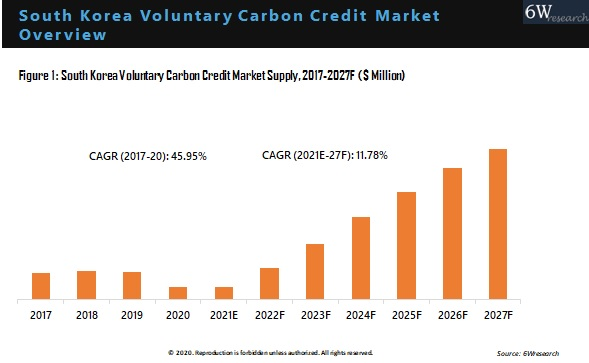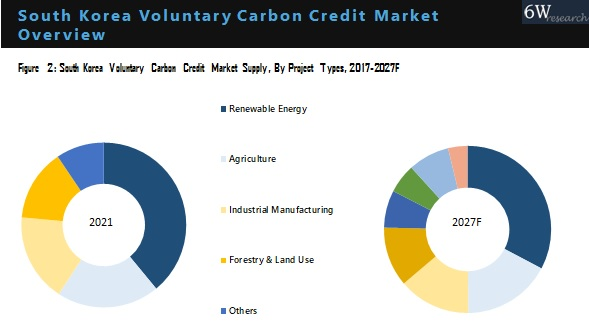South Korea Voluntary Carbon Credit Market Outlook (2021-2027) | Forecast, Size, Analysis, Revenue, Value, Trends, Growth, COVID-19 IMPACT, Industry, Companies & Share
Market Forecast By Types (Voluntary and Compliance), By Project Types (Forestry & Land Use Project, Transportation, Industry and Others), And Competitive Landscape.
| Product Code: ETC072163 | Publication Date: May 2022 | Product Type: Market Research Report | |
| Publisher: 6Wresearch | No. of Pages: 80 | No. of Figures: 14 | No. of Tables: 8 |
South Korea Voluntary Carbon Credit Market report comprehensively covers the market by types and by project types. South Korea Voluntary Carbon Credit market report provides an unbiased and detailed analysis of the ongoing trends, opportunities/high growth areas, and market drivers which would help the stakeholders to devise and align their market strategies according to the current and future market dynamics.
South Korea Voluntary Carbon Credit Market Synopsis
The voluntary carbon credit market in South Korea is very small owing to the presence of an established national compliance market. However, in order to capitalize on the rapidly growing global voluntary carbon credit, carbon credit providers in the country are now shifting their focus to international voluntary markets. This is expected to augment carbon offset transactions and supply from the country. However, the outbreak of COVID-19 pandemic has resulted in a slowdown in the projects, especially during 2020 and the market has recovered gradually over the next few years.

According to 6Wresearch, South Korea Voluntary Carbon Credit market is expected to grow at a CAGR of 11.7% during 2021-2027. According to South Korea Emissions Trading Scheme (ETS) regulation, Korean companies can use voluntary carbon credit for up to 5% of their total carbon emission submission. However, a shift in focus can enable project developers to provide offsets to international markets.
Market Analysis By Project Type
The agriculture sector held the highest revenue share in the overall South Korea Carbon Credit Market. Additionally, renewable energy and forestry & land-use projects are witnessing substantial growth, leading to the growth of the voluntary carbon credit market in South Korea.

Key Attractiveness of the Report
- COVID-19 Impact on the Market.
- 6 Years Market Numbers.
- Estimated Data Starting from 2021 to 2027F.
- Base Year: 2021
- Forecast Data until 2027F.
- Key Performance Indicators Impacting the Market.
- Major Upcoming Developments and Projects.
Key Highlights of the Report:
- South Korea Carbon Credit Market Overview
- South Korea Carbon Credit Market Outlook
- South Korea Carbon Credit Market Forecast
- Historical Data and Forecast of South Korea Carbon Credit Market Transaction Values, for the Period 2017-2027F
- Historical Data and Forecast of South Korea Carbon Credit Market Values, for the Period 2017-2027F
- Historical Data and Forecast of South Korea Carbon Credit Market, By Types, for the Period 2017-2027F
- Historical Data and Forecast of South Korea Carbon Credit Market, By Project Types, for the Period 2017-2027F
- Impact Analysis of Covid-19
- Market Drivers, Restraints, and Trends
- Key Performance Indicators
- Industry Life Cycle & Porter’s Five Force Analysis
- Market Opportunity Assessment
- Key Strategic Recommendations
Market Scope and Segmentation
The report provides a detailed analysis of the following market segments:
By Types
- Voluntary
- Compliance
By Project Types
- Forestry & Land Use Project
- Transportation
- Industry
- Others
Frequently Asked Questions About the Market Study (FAQs):
| 1 Executive Summary |
| 2 Introduction |
| 2.1 Key Highlights of the Report |
| 2.2 Report Description |
| 2.3 Market Scope & Segmentation |
| 2.4 Research Methodology |
| 2.5 Assumptions |
| 3 South Korea Carbon Credit Market Overview |
| 3.1 South Korea Carbon Credit Market Transaction Values (2017-2027F) |
| 3.2 South Korea Carbon Credit Market Supply and Demand, In MtCO2e (2017-2027F) |
| 3.3 South Korea Carbon Credit Market Industry Life Cycle |
| 3.4 South Korea Carbon Credit Market Porter’s Five Forces Model |
| 3.5 South Korea Carbon Credit Market Ecosystem |
| 3.6 South Korea Carbon Credit Market Value Share, By Types (2020 & 2027F) |
| 3.7 South Korea Carbon Credit Market Value Share, By Regions (2020 & 2027F) |
| 4 South Korea Carbon Credit Market Dynamics |
| 4.1 Impact Analysis |
| 4.2 Market Drivers |
| 4.3 Market Restraints |
| 5 South Korea Carbon Credit Market Trends & Evolution |
| 6 South Korea Carbon Credit Market - Impact Analysis of COVID-19 |
| 7. South Korea Voluntary Carbon Credit Market Overview |
| 7.1 South Korea Voluntary Carbon Credit Market Supply, By Project Type (2017-2027F) |
| 8. South Korea Carbon Credit Market - Key Performance Indicators |
| 9. South Korea Carbon Credit Market - Price Trend Analysis (2017-2027F) |
| 10. South Korea Carbon Credit Market - Country Initiatives & Regulatory Scenario |
| 11. Analysis of Key Participants Involved in Carbon Credit Market |
| 12. South Korea Carbon Credit Market - Opportunity Assessment |
| 13. South Korea Carbon Credit Market Competitive Landscape |
| 14. Company Profiles |
| 15. Key Strategic Recommendations |
| 16. Disclaimer |
- Single User License$ 1,995
- Department License$ 2,400
- Site License$ 3,120
- Global License$ 3,795
Search
Related Reports
- India Wallpaper Market (2025-2031) | Forecast, Revenue, Industry, Companies, Outlook, Size, Analysis, Value, Growth, Share, Trends
- Thailand Artificial Flower Market (2025-2031) | Value, Industry, Outlook, Trends, Forecast, Size, Revenue, Companies, Analysis, Share & Growth
- United Arab Emirates Nitrogenous Fertilizers Market (2025-2031) | Outlook, Analysis, Industry, Forecast, Trends, Companies, Growth, Value, Size, Share & Revenue
- Germany Genset Rental Market (2025-2031) | Analysis, Share, Industry, Growth, Revenue, Companies, Trends, Outlook, Forecast, Value & Size
- Ethiopia Genset Rental Market (2025-2031) | Trends, Analysis, Companies, Revenue, Size, Forecast, Value, Outlook, Growth, Industry & Share
- Kenya Genset Rental Market (2025-2031) | Growth, Revenue, Value, Share, Trends, Forecast, Outlook, Companies, Industry, Size & Analysis
- South Africa 800kW and Above Gas Engine for Generators Market (2025-2031) | Size, Share, Value, Industry, Companies, Trends, Analysis, Outlook, Revenue, Growth & Forecast
- South Africa Emergency and Exit Lighting Systems Market (2025-2031) | Trend, Size, Share, Growth, Revenue, Analysis & Outlook
- Turkey Emergency and Exit Lighting Systems Market (2025-2031) | Size, Share, Growth, Forecast, Revenue, industry, Analysis & Outlook
- Thailand Electric Vehicle Charging Infrastructure Market (2025-2031) | Share, industry, Growth, Revenue, Forecast, Outlook & Outlook
Industry Events and Analyst Meet
Our Clients
Whitepaper
- Middle East & Africa Commercial Security Market Click here to view more.
- Middle East & Africa Fire Safety Systems & Equipment Market Click here to view more.
- GCC Drone Market Click here to view more.
- Middle East Lighting Fixture Market Click here to view more.
- GCC Physical & Perimeter Security Market Click here to view more.
6WResearch In News
- India's Printer Market Faces 20.7% Decline in Q4 2023: Epson and HP Lead Amidst Downturn
- India's Camera Market Sees 8.9% Decline in Q4 2023; Canon Leads with 38.4% Share
- Doha a strategic location for EV manufacturing hub: IPA Qatar
- Demand for luxury TVs surging in the GCC, says Samsung
- Empowering Growth: The Thriving Journey of Bangladesh’s Cable Industry
- The future of gaming industry in the Philippines













